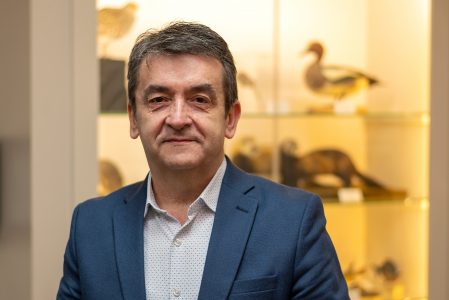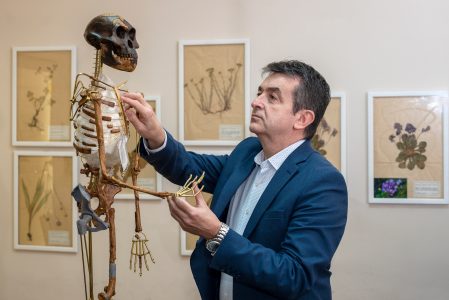Although, when we hear the word ‘museum’, our first association is its permanent exhibition, we have proved and shown, even without an adequate space, that a permanent exhibition is not the only precondition for visibility or an indicator of the value of a museum.

Almost two million geological and biological specimens kept in 125 collections, a specialised scientific library with more than 22,000 books, 40 employees including top experts who take care of all this, and more than 100,000 visitors in Serbia – this is the shortest way to describe the Natural History Museum using numbers. We spoke with the acting Director of the Museum of Natural History in Belgrade, Slavko Spasić, about the important jubilee, but also about the treasure that is hidden in the Museum depots, whether the Museum will be given a new building, and about the role of natural history museums in the 21st century.
In its 125 years of existence, the how did the Natural History Museum keep, and preserve, the natural heritage not only of Serbia but also the world?
Museum exists 125 years and is not just a number. It is actually 125 years of collecting, preserving, studying and exhibiting movable cultural assets from nature, 125 years of organising exhibitions, scientific research, education, publishing and cooperating with other institutions from the country and the world, thanks to all the employees of the Museum, but especially curators. Their work is enormous and impressive, but often insufficiently visible to the public. Exhibitions are just the tip of the iceberg. Our museum was founded as the first institution specialised for scientific study, protection and presentation of national natural heritage. Today, it is a cultural institution of national importance. That is impressive, but also obliging.
What interesting exhibits does the Museum keep in its collections?
The initial collections, dating to the first half of the 19th century, were collected and kept first in the Lyceum, and then in the Natural History Cabinet of the Great School, under the leadership of Josip Pančić, the first Serbian botanist and rector of the Great School. The geological and biological collections of our Museum are a unique and exclusive journey through space and time. They speak of the origin of our planet, the world around us, but also of the extinction of species.
The geological and biological collections of our Museum are a unique and exclusive journey through space and time
In our Museum, we have, for example, a Glossopteris, one of the oldest fossils in the world, as well as species that can no longer be found on Earth, such as the Kragujevac mallow, Vranje mallow or a flamingo that was caught in 1926 in Banat. Also, there are several hundred holotypes, i.e. ‘keys’ for species identification or physical specimens of organisms that started being used when certain species were first formally described.
The Museum also has meteorites, the one from Sokobanja, which was found in 1887, from Jelica, which fell in 1889, and from Dimitrovgrad, which was discovered in 1948. In the depots of the Museum we keep an exhibit of a bear from Jastrebac, shot in 1885. Its history is especially interesting, because it used to adorn the halls of the Old Palace and was there during the May coup, when members of the royal dynasty of Obrenović were tragically killed.
What is your favourite museum item?
As a biologist and a great lover of nature, it is difficult for me to choose just one, because they all have their own unique stories and value. I am fascinated by endowers and their legacies, especially the legacy of Archibald Rice, a Swiss forensic scientist, publicist, doctor of chemistry and professor at the University of Lausanne. Apart from being a great friend of the Serbian people during the First World War, he was also a great lover of nature. It is little known that, after the War, Rice liked to spend his free time in nature, and that he passionately collected specimens of butterflies and birds around Belgrade. He would donate specimens – which are still carefully preserved in our collections – to the then Museum, which he often visited.
The first permanent exhibition of the Museum was ceremoniously opened on 7 September 1904, on the day of the centenary of the First Serbian Uprising. King Peter I Karadjordjević also attended the event. From that day forward, the Museum has held a large number of exhibitions.
One of the main tasks of the Museum is to preserve and promote natural cultural heritage. In the past 125 years, we have exhibited a large number of specimens from our depots and hosted the exhibitions of other museums from the around the country and the region, while simultaneously also presenting ourselves to audiences from Serbia. Today, the Museum follows modern trends in museology and science, adapting to modern times and the needs of the public.

Before the pandemic, our Gallery on Kalemegdan had, on average, more than 35,000 visitors per year. Also, numerous visiting exhibitions were seen by more than 100,000 visitors per year in other museums throughout Serbia. In the past two years, we have continued to organise exhibitions, but we have also provided nature lovers with virtual tours, although we know that the experience of seeing exhibits in a gallery space is irreplaceable.
Of course, each exhibition is accompanied by workshops for children, to which we pay special attention because they often represent children’s first contact with the Museum. That is where they build awareness of the nature that surrounds us and the need to preserve it.
Are there any diplomats among the visitors?
Diplomats are very interested in our country’s rich culture, and they frequently visit our Museum with their families. Recently, in cooperation with Color Media Communications and your magazine, we held a guided tour of the exhibition “Caviar” for more than 30 representatives of the diplomatic corps. The author of the exhibition was Dubravka Vučić, senior curator and ichthyologist. It was a very special event, and we would like to express our sincere gratitude both to you and the embassies.
Still, the Museum is located in temporary accommodation, without adequate conditions required for proper work, storage and protection of collections. It also has no permanent exhibition. Are you expecting a new building, and if so, when?
Although, when we hear the word ‘museum’, our first association is its permanent exhibition, by operating for 125 years without adequate space we have proven, and shown, that a permanent exhibition is not the only prerequisite for visibility, or an indicator of the value of a museum. Working conditions were – and still are – often very difficult, sometimes almost impossible. Our exhibits and the needs of the Museum are very specific. Imagine how much space is needed to store, or exhibit, the skeleton of a mammoth, or a bear, or a griffon vulture with its wings outstretched. Still, our activity survived thanks to the great enthusiasm and love of all those who have worked, and are currently working, at the Museum.
Our activity survived thanks to the great enthusiasm and love of all those who have worked, and are currently working, at the Museum.
This year, the Ministry of Culture and Information has allocated funds for the development of the terms of reference, and next year we plan to announce an urban-architectural competition for the conceptual design of the Museum building. Based on the detailed regulation plan, the Natural History Museum building will be constructed in the area of the “Friendship Park” – Ušće, in New Belgrade. We are extremely happy about this, because we know how much the public will love to see, in a permanent exhibition, all the wealth that is stored in our depots, and how much easier our future work will be.
Have you made a promise to yourself, privately, that the Museum will get a building during your tenure?
Yes, I did. I believe, and so does the entire team of the Natural History Museum, that our country, which is rich in natural resources, deserves a Natural History Museum like those that exist in other capitals around the world. The state has become aware of this, and we will do our best to make it happen.
You were the President of the National Committee of ICOM Serbia for many years, and now you are the Vice President of the ICOM Regional Alliance for Southeast Europe. What is the status of our museums in relation to those around the world, and to what extent has international cooperation been developed?
ICOM (International Council of Museums) is the largest global network of museum professionals in the UNESCO system, with almost 50,000 members from all over the world. One of the 118 national committees is the one from Serbia, which has the most members in the region. Serbian museums show an exceptional level of engagement and creativity, which they achieve through intensive regional cooperation and involvement in the work of International Committees.
The Museum recently organised an online conference entitled ‘Natural History Museums for the 21st Century’, supported by Ministry of culture and information, which was attended by representatives of the most prestigious natural history museums in the world. So, what are the conclusions? What place will museums occupy in the 21st century?
One of the conclusions of this conference was that despite the rich digital content, it is still important to attract people and bring them to museums. We talked about new post-Covid strategies, digitalisation, as well as the importance of endowments in the development of collections. Another topic of the conference was the preservation of nature and life in it. It is a topic that is highly current today, but I am afraid it will become even more current in the time ahead. We agreed that the task of the natural history museums in the coming period will be to actively participate in the preservation of the Earth, but also to inspire people around the planet to join, both as individuals and institutions, and give their personal contribution to this noble goal.